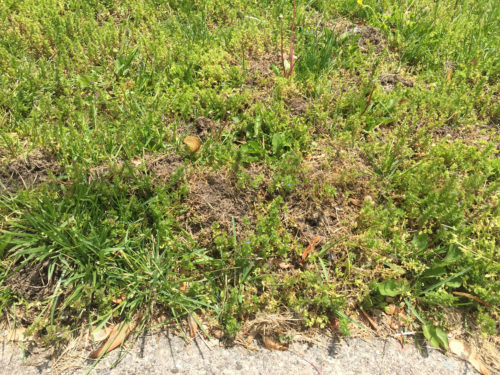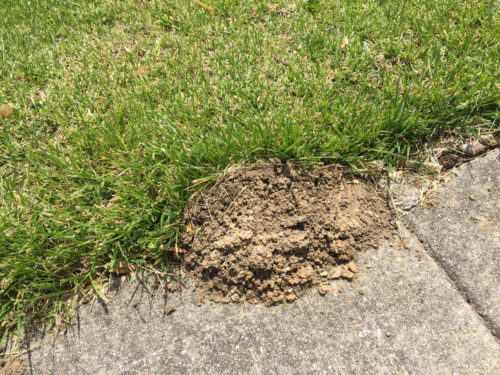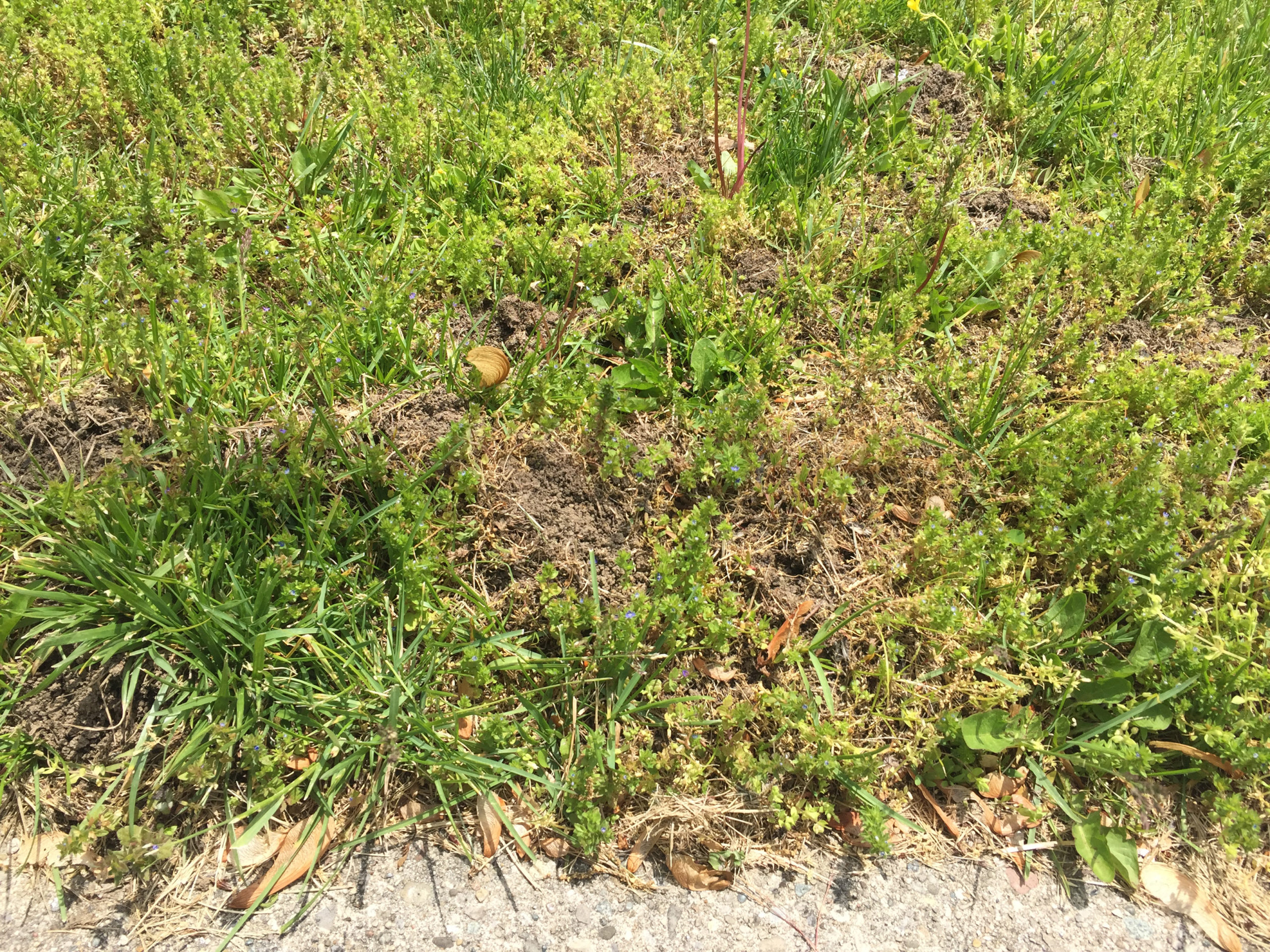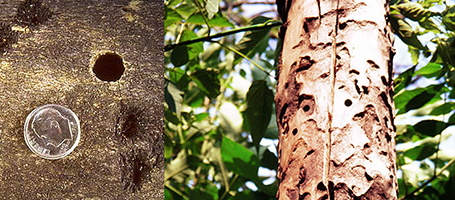 Purdue University - Extension - Forestry and Natural Resources
Purdue University - Extension - Forestry and Natural Resources
Got Nature? Blog
Purdue sustaining hardwood extension specialist Lenny Farlee talks about identifying invasive plant species in the webinar below.
Don’t forget to fill out the Invasive Plants Threaten our Woodlands Part 1, Identification survey after watching video to share your suggestions, other forest topics you would like to see and to help us learn more about you.
Resources
A Woodland Management Moment, Playlist, Purdue Extension – Forestry and Natural Resources Youtube Channel
Invasive Species, Playlist
Report Invasive Species, Purdue Invasive Species
The GLEDN Phone App – Great Lakes Early Detection Network
EDDMaps – Early Detection and Distribution Mapping System (Report Invasives)
Cooperative Invasive Species Management Area (CISMA)
Indiana Department of Natural Resources: Invasive Species
Indiana Invasive Species Council
Woodland Stewardship for Landowners, Playlist
Invasive plants: impact on environment and people, The Education Store, Purdue Extension resource center
Woodland Invaders, Got Nature? Blog
Indiana Invasive Species Council
Hardwood Tree Improvement & Regeneration Center (HTIRC)
Lenny Farlee, Sustaining Hardwood Extension Specialist
Purdue University Department of Forestry and Natural Resources
Recently during an online program (video) I received a question about the risk of using toxicants for controlling moles in lawns. Specifically, the question was if animals (pets or wild animals) ate the moles that consumed the bromethalin “worms” or “grubs” would that harm them. I decided to do some digging (no pun intended) for more information so people can make informed decisions regarding their use.
What is bromethalin?
From the Purdue University Animal Disease and Diagnostic Laboratory:
“Bromethalin was developed and released in 1985 to combat a world-wide problem of rodent resistance to warfarin-like anticoagulant rodenticides. Bromethalin is not an anticoagulant but is a highly potent rodenticide that provides a lethal dose to rodents in a single feeding. Death occurs within 24 to 36 hours after ingestion. It is a pale, odorless, crystalline solid compound in the diphenylamine family. Its mechanism of action is to uncouple oxidativephosphorylation in the mitochondria of the central nervous system. This leads to a decreased production of ATP. Low levels of ATP inhibit the activity of the Na/K ATPase and lead to a subsequent buildup of cerebral spinal fluid and vacuolization of myelin. The increased CSF results in high intracranial pressure, causing damage to nerve axons, inhibiting neural transmission and leading to paralysis, convulsions and death. Signs of a sub-lethal dose include hind limb ataxia, depression, extensor rigidity, opisthotonus, lateral recumbency and vomiting. High doses may bring about severe muscle fasciculations, hind limb hyper-reflexia, seizures, hyperthennia, depression and death.”
From the Merk Veterinary Manual:
“Bromethalin, a nonanticoagulant, single-dose rodenticide, is a neurotoxin available as bars (blocks), pellets, seed, and worm. Mole baits are sold as worm containing 0.025% bromethalin, whereas rat and mouse baits contain 0.01% bromethalin. Bromethalin and its main metabolite desmobromethalin are strong uncouplers of oxidative phosphorylation. This results in intra-myelin fluid accumulation, leading to long nerve demyelination and intra-myelin cerebral edema. The net result is cerebral and spinal edema and increased CSF pressure, leading to neurologic dysfunction. In toxicity trials, the oral toxic dose of bromethalin when used as part of bait appears to be much lower than the dose administered as a technical grade agent. For example, in dogs, an average lethal dose of technical grade bromethalin is reported to be 4.7 mg/kg but 2.38 mg/kg in bait. Young dogs (<1 yr old) appear more sensitive; death has been reported at dosages of ~1 mg/kg in bait. Dogs are more commonly involved. Cats are 2–3 times more sensitive than dogs.”
What is the risk with mole baits?
The level of risk of any pesticide depends on a combination of toxicity and exposure. Anytime you are considering using a toxicant or other pesticide, first read the label in its entirety. Labels will contain information on how to apply a product safely, under what circumstances, and any precautions you should take. However, labels also contain other information that can users determine if they should use a product. This information is key in preventing pesticide exposure to people and the environment. In fact the label is a legal document. The pesticide user is bound by law to follow all label directions. Label directions for mole baits instruct users to keep pets out of treated areas and not to use the product above ground. Bait must be applied directly into moles’ tunnel systems. Following these directions will greatly reduce, or even eliminate, the exposure risk to pets. What might be the consequences if your dog or a neighbor’s dog mistakenly entered your yard and went digging around in a treated area?
To determine this we can calculate how much bait a dog would have to consume to reach the average lethal dose. The more technical term is the LD50 dose which is the individual dose that kills 50 percent of a population of test animals. A single worm mole bait weighs approximately 5g since a package of 20 worms has a weight of 100g. With 0.025% active ingredient, each worm would contain 1.25 mg of bromethalin. Thus, an 11lb (5kg) dog would need to consume 18 to 19 worms to reach the average lethal dose using the 4.7 mg/kg level for technical grade bromethalin, or 9 to 10 worms for the 2.38 mg/kg level in bait. Recall, these rates were listed in the Merk Veterinary Manual. The amount of bait consumption would be more for larger dogs. The average lethal dose is just that – an average. Some dogs would die with lower dosages and some with higher dosages within a specified timeframe.
It would be extremely unlikely that a dog could find, dig up, and consume the number of worms to reach or even approach the average lethal dose. Consider the following:
- How many worm baits will you use? According to label directions, worm baits are placed underground every 5 to 10 feet in active subsurface runways. Worms may be placed in the deeper underground runways. Limiting their use to only active runways reduces the amount of product applied. The label directions outline the procedure for identifying active runways.
- Applying the product according to label instructions (in underground active mole tunnels) helps minimize the risk of accidental ingestion. However there are additional strategies to prevent accidental ingestion of the bait, including: applying the product in areas inaccessible to pets or installing barriers, covering the application sites with pavers, and supervising the pet’s use of the yard (especially important for dogs that like to dig). Allow at least two weeks (or longer under dry conditions) for breakdown of any uneaten worms.
- Toxic baits placed in runways breakdown over time. That is, a treated area is not treated forever. This is a direct quote from one manufacturer, “Uneaten worms typically remain intact up to 14 days in mole runs. The amount of time it takes for the Mole Killer worm to degrade depends on soil type and the weather. Frequent and heavy rain or high temperatures may accelerate worm degradation. The active ingredient takes longer to degrade.”
- Toxic baits may be combined with other methods. For example, you may choose to limit use of toxic baits only in areas where the soil type or tunnel structure make trapping difficult.
In the end, it is up to the individual user on whether or not they choose to use toxic baits to get rid of moles in their yard. If you do choose to use them, read the label in its entirety. In the case of mole toxicants, the label clearly states that pets should not be allowed in treated areas. If you are not confident this is possible, then alternative control options are likely a better option for you.
Resources
Pesticides and personal safety (pdf), Purdue Pesticide Program
Pesticides and wildlife (pdf), Purdue Pesticide Program
Moles, The Education Store, Purdue Extension resource center
Adjuvants and the Power of the Spray Droplet: Improving the Performance of Pesticide Applications, The Education Store
Purdue Extension – FNR: Ask An Expert, Video, Purdue Extension – Forestry and Natural Resources YouTube channel
Brian MacGowan, Wildlife Extension Specialist
Purdue University, Department of Forestry and Natural Resources
One of the challenges of living, even in urban areas, is dealing with white-tailed deer and browsing damage that they can cause. In this video by Purdue extension wildlife specialist Brian MacGowan, he will show you how to protect you newly planted trees and shrubs from white-tailed deer and other wildlife that can cause damage.
Resources
How to Stop Woodland Animals from Digging in Your Flower Pots, Video, Purdue Extension Youtube Channel
How to Attract “The Fascinating Hummingbirds” to Your Backyard, Video
Woodland Management Moment – Deer Fencing, Video
Tree Appraisal and the Value of Trees, The Education Store, Purdue Extension resource center
Brian MacGowan, Wildlife Extension Specialist
Purdue Forestry and Natural Resources
Purdue Forestry & Natural Resources extension specialists gathered for a Facebook LIVE event held May 5th to answer questions on a wide range of topics from woodland management to wildlife habitat, ponds to invasive species and more.
Topics ranged from what to do about moles, voles and Canada geese causing damage in your yard, to how to pick the right tree for your landscape and how to measure the worth of your trees. The presentation also included segments on what to do about algae in your pond to how to know if you need to restock it as well as what to do about invasive plant species and how to protect your trees from deer damage.
Get advice from extension specialists Jarred Brooke, Lenny Farlee, Brian MacGowan, Lindsey Purcell, Rod Williams and Mitch Zischke in the video below.
If you have any further questions feel free to send your questions by submitting our Ask An Expert form.
Resources mentioned:
Purdue Extension – The Education Store
Purdue Report Invasive Species Website
Midwest Invasive Species Network Database
TreesAreGood.org
Find a Forester in Indiana
Improve My Property for Wildlife, Purdue Extension
Online Mole Program, Event May 14th, Purdue FNR Extension
Have you seen a hairless squirrel, Got Nature? Blog, Purdue FNR Extension
Stocking Fish, The Education Store, Purdue Extension Resource Center
Tree Selection for the “Un-natural” Environment, The Education Store
Selecting a Nuisance Control Operator, The Education Store
Forest Products Price Report (pdf), Indiana Department of Natural Resources (IDNR)
Indiana DNR Nuisance Goose Control Options (pdf), Indiana Department of Natural Resources (IDNR)
Turtles of Indiana, The Education Store
Salamanders of Indiana, The Education Store
Frogs and Toads of Indiana, The Education Store
Snakes and Lizards of Indiana, The Education Store
Aquatic Plant Management, The Education Store
Native Grasses, The Education Store
Preventing Deer Browsing on Trees/Shrubs, Video, Purdue Extension Youtube Channel
Brian MacGowan, Wildlife Extension Specialist
Purdue University, Department of Forestry and Natural Resources
For such a small creature, moles can cause big headaches. Their tunneling behavior can cause extensive damage to turf areas if left unchecked. While the damage is easy to identify, solving it can be tricky.
Purdue wildlife specialist, Brian MacGowan, shared tips and control techniques including trapping, repellents, toxicants, and cultural methods as well as answer your questions on the topic on Facebook LIVE, Thursday, May 14th.
You can view this topic along with question and answer time on the Purdue FNR Facebook page: https://www.facebook.com/PurdueFNR/videos/3372718849422210/.
If you have any further questions feel free to place your question in the comment section on our Purdue FNR Facebook page on the video link above or you can send your question by submitting an Ask An Expert form.
Resources
Moles, The Education Store, Purdue Extension resource center
Adjuvants and the Power of the Spray Droplet: Improving the Performance of Pesticide Applications, The Education Store
Preventing Wildlife Damage – Do You Need a Permit?, The Education Store
Attract Hummingbirds to Your Yard, Video, Purdue Extension Youtube Channel
How to Stop Woodland Animals from Digging in Your Flower Pots, Video, Purdue Extension Youtube Channel
Brian MacGowan, Wildlife Extension Specialist
Purdue Forestry and Natural Resources
Question:
Are these pretty green flower shaped growth spots lichens? It just appeared on my tree this year. With this type of fungus should I be worried that it could damage the tree?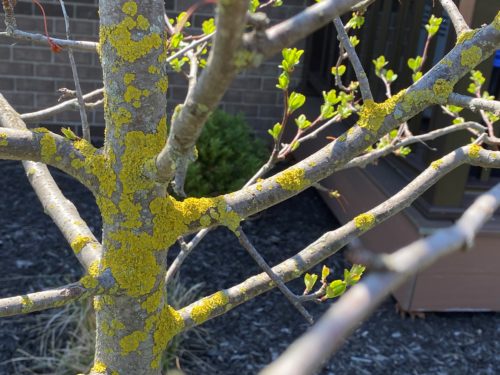
Answer:
Lichen is common on trees and not bad either. Those grayish-green patches, come in all sizes and shapes and sometimes covering much of the tree, are not feeding on your woody plants. Lichens grow on the surface of the tree, and do not penetrate any tissue. Instead, they make use of the trunk or branches for support. They can be aesthetically pleasing for many. Lichens play a very significant role as a bio-indicator. They only grow where the air quality is good and have a favorable growing environment. They help filter the air as well… so, don’t worry, be happy!
Resources:
Lichens, Purdue Botany & Plant Pathology
Purdue Plant & Pest Diagnostic Lab, Purdue Botany & Plant Pathology
Diseases of Landscape Plants: Leaf Diseases, The Education Store, Purdue Extension resource center
Surface Root Syndrome, The Education Store
Tree Installation: Process and Practices, The Education Store
Purdue Landscape Report, Purdue University
Lindsey Purcell, Urban Forestry Specialist
Purdue University, Department of Forestry and Natural Resources
Do you have issues with wildlife digging in your flower pots and disturbing or even killing your plants? Extension wildlife specialist Brian MacGowan has a few simple tips that you can try in order to deter these animals and save your plants.
Resources:
Preventing Wildlife Damage – Do You Need a Permit? – The Education Store, Purdue Extension resource center
Selecting a Nuisance Wildlife Control Professional, The Education Store
How to Construct a Scent Station, The Education Store
Question: How do I properly relocate raccoons from my attic?, Got Nature? Blog, Purdue Extension FNR
Nuisance Wildlife, Indiana Department of Natural Resources
Brian MacGowan, Wildlife Extension Specialist
Purdue Forestry and Natural Resources
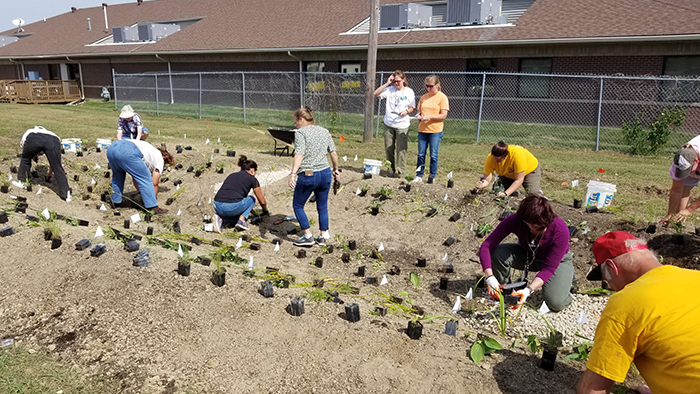
The Purdue Extension and Illinois-Indiana Sea Grant Rainscaping Education Program was highlighted in the National Oceanic and Atmospheric Administration’s Education Accomplishments Report (pdf) for fiscal year 2019.
This report highlighted all of NOAA’s greatest accomplishments related to education in five main goal areas: science informed society, conservation and stewardship, safety and preparedness, future workforce and organizational excellence.
The Rainscaping Education Program was featured in the Conservation and Stewardship section of the report. The Purdue Rainscaping Education Program offers state-wide training for Purdue Master Gardeners, conservation agencies and organizations, stormwater professionals and landscape companies and consultants. Through two-day workshop sessions, the program provides an introduction to rainscaping and rain gardens, including segments on site selection, plant selection, garden design, installation, maintenance and community engagement.
“It is wonderful to have the innovative and collaborative work of the Purdue Rainscaping Education Team recognized for its efforts,” Kara Salazar, assistant program leader and extension specialist for sustainable communities said. “The team has been working together since 2013 to develop and implement the interdisciplinary program addressing the need for community education on sustainable landscape practices to prevent polluted runoff.”
Salazar and John Orick, Purdue Master Gardener State Coordinator, are co-leads on the project. View the full Rainscaping Team.
The featured segment on the Rainscaping program from the NOAA annual report is below.
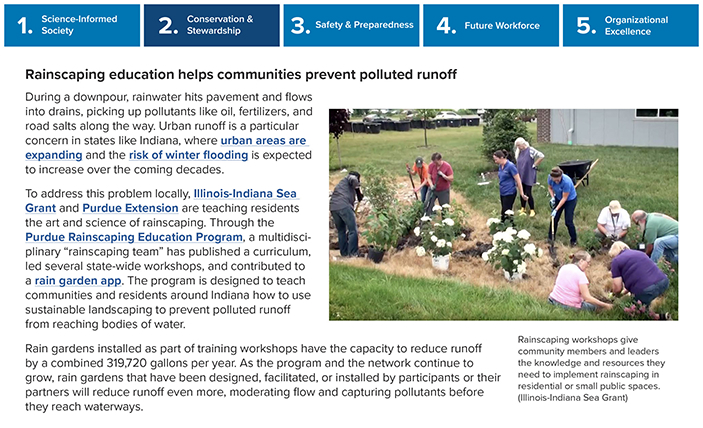
Resources
What is Rainscaping? Purdue Rainscaping Education Program Video, Purdue Extension
Sustainable Communities Extension Program, Purdue Extension
Q&A About Drainage Water Recycling for the Midwest, The Education Store, Purdue Extension resource center
Become a Purdue Master Gardener, The Education Store
Plan Today For Tomorrow’s Flood, The Education Store
Kara Salazar, Assistant Program Leader and Extension Specialist for Sustainable Communities
Department of Forestry and Natural Resources
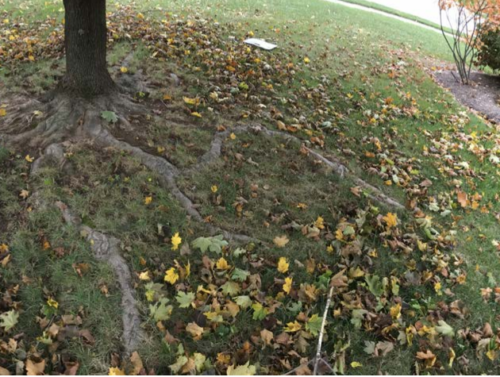 Trees in the landscape are highly prized and provide many benefits to you and your home. However, those shallow roots that appear on the surface of our lawns can create real headaches, especially when trying to grow lush turfgrass. This free download Surface Root Syndrome publication will help you learn what surface roots are, common approaches to address the problem, and best practices to management.
Trees in the landscape are highly prized and provide many benefits to you and your home. However, those shallow roots that appear on the surface of our lawns can create real headaches, especially when trying to grow lush turfgrass. This free download Surface Root Syndrome publication will help you learn what surface roots are, common approaches to address the problem, and best practices to management.
Resources
Find an Arborist video, Trees are Good-International Society of Arboriculture (ISA)
Caring for storm-damaged trees/How to Acidify Soil in the Yard – In the Grow, Purdue Extension
Tree Appraisal and the Value of Trees, The Education Store, Purdue Extension resource center
Tree Support System, The Education Store
Why Is My Tree Dying? – The Education Store
Tree Risk Management – The Education Store
Mechanical Damage to Trees: Mowing and Maintenance Equipment – The Education Store
Trees and Electric Lines – The Education Store
Urban Forestry Playlist, Purdue Extension-Forestry and Natural Resources YouTube Channel
Lindsey Purcell, Chapter Administrator & Master Arborist
Indiana Arborist Association
United States Department of Agriculture Animal and Plant Health Inspection Service Bulletin: USDA declares August Tree Check Month and urges public to look for Asian longhorned beetle.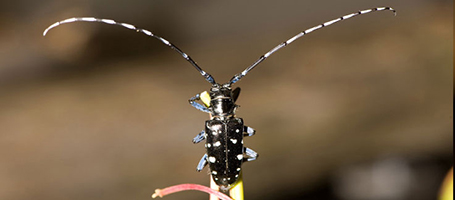
WASHINGTON, July 23, 2019 — August is the height of summer, and it is also the best time to spot the Asian longhorned beetle (ALB) as it starts to emerge from trees. The U.S. Department of Agriculture (USDA) is asking the public to take five minutes to step outside and report any signs of this invasive pest. Checking trees for the beetle will help residents protect their own trees and better direct USDA’s efforts to eradicate this beetle from the United States.
“It’s important to look for signs of the beetle now, because it’s slow to spread during the early stages of an infestation,” said Josie Ryan, APHIS’ National Operations Manager for the ALB Eradication Program. “With the public’s help, we can target new areas where it has spread and provide a better chance of quickly containing it.”
The Asian longhorned beetle feeds on a wide variety of popular hardwood trees, including maple, birch, elm, willow, ash and poplar. It has already led to the loss of more than 180,000 trees. Active infestations are being fought in three areas of the country: Worcester County, MA, Long Island, NY (Nassau and Suffolk Counties), and Clermont County, Ohio.
“Homeowners need to know that infested trees do not recover and will eventually die, becoming safety hazards,” warned Ryan. “USDA removes infested trees as soon as possible because they can drop branches and even fall, especially during storms, and this keeps the pest from spreading to nearby healthy trees.”
The Asian longhorned beetle has distinctive markings that are easy to recognize:
- Antennae that are longer than the insect’s body with black and white bands.
- A shiny, jet-black body with white spots, about 1” to 1 ½” long.
- Six legs and feet, possibly bluish-colored.
- Round exit holes in tree trunks and branches about the size of a dime or smaller.
- Shallow oval or round scars in the bark where the adult beetle chewed an egg site.
- Sawdust-like material called frass, laying on the ground around the tree or in the branches.
- Dead branches or limbs falling from an otherwise healthy-looking tree.
After seeing signs of the beetle:
- Make note of what was found and where. Take a photo, if possible.
- Try to capture the insect, place in a container, and freeze it. This will preserve it for easier identification.
- Report findings by calling 1-866-702-9938 or completing an online form at USDA Animal and Plant Health Inspection Service.
It is possible to eliminate this pest and USDA has been successfully doing so in several areas. Most recently, the agency declared Stonelick and Batavia Townships in Ohio to be free of the Asian longhorned beetle. We also eradicated the beetle from Illinois, New Jersey, Boston, MA, and parts of New York. The New York City boroughs of Brooklyn and Queens are in the final stages of eradication.
For more information about the Asian longhorned beetle, other ways to keep it from spreading—such as not moving firewood—and eradication program activities, visit USDA Animal and Plant Health Inspection Service. For local inquiries or to speak to your State Plant Health Director, call 1-866-702-9938.
Other Resources:
Report Invasive Species, Purdue Agriculture & Indiana Invasive Species Council
Great Lakes Early Detection Network, Bugwood Apps
New Hope for Fighting Ash Borer, Got Nature? Blog
Mile-a-Minute Invasive Vine Found Indiana, Got Nature? Blog
Sericea Lespedeza: Plague on the Prairie, Got Nature? Blog
Invasive Plants: Impact on Environment and People, The Education Store, Purdue Extension
Invasive Plant Species in Hardwood Tree Plantations, The Education Store
Invasive Plant Species: Callery Pear, Purdue Extension The Education Store
United States Department of Agriculture Animal and Plant Health Inspection Service
Recent Posts
- Leaving Leaves Benefits Wildlife – Wild Bulletin
Posted: November 11, 2024 in Forestry, Forests and Street Trees, Gardening, Urban Forestry, Wildlife - Purdue Extension’s Showcase, Impacting Indiana
Posted: November 8, 2024 in Community Development, Forestry, Forests and Street Trees, Gardening, Land Use, Natural Resource Planning, Timber Marketing, Urban Forestry, Wildlife, Wood Products/Manufacturing, Woodlands - When Roundup Isn’t Roundup – Purdue Landscape Report
Posted: October 17, 2024 in Forestry, Gardening, Plants, Urban Forestry - Celebrate Pollinator Week With Flowers of June Tour
Posted: June 20, 2024 in Forestry, Gardening, Wildlife - Ask An Expert: What’s Buzzing or Not Buzzing About Pollinators, Webinar
Posted: July 4, 2023 in Forestry, Gardening, How To, Plants, Wildlife - Magnificent Trees of Indiana Webinar
Posted: May 12, 2023 in Forestry, Forests and Street Trees, Gardening, Got Nature for Kids, Urban Forestry, Webinar, Woodlands - Be Tick Aware: Lyme Disease & Prevention Strategies Webinar
Posted: May 11, 2023 in Alert, Forestry, Forests and Street Trees, Gardening, How To, Urban Forestry, Webinar, Wildlife, Woodlands - Illinois Groundwork provides a rich supply of green infrastructure resources – IISG
Posted: in Gardening, Land Use, Plants, Wildlife - Pseudomonas syringae pv. syringae on lilac and other woody ornamentals – Landscape Report
Posted: May 3, 2023 in Forestry, Forests and Street Trees, Gardening, How To, Plants, Safety, Urban Forestry, Woodlands - Publication-Introduction to Rain Garden Design
Posted: April 24, 2023 in Forestry, Gardening, How To, Plants
Archives
Categories
- Alert
- Aquaculture/Fish
- Aquatic/Aquaculture Resources
- Ask the Expert
- Christmas Trees
- Community Development
- Disease
- Drought
- Forestry
- Forests and Street Trees
- Gardening
- Got Nature for Kids
- Great Lakes
- How To
- Invasive Animal Species
- Invasive Insects
- Invasive Plant Species
- Land Use
- Natural Resource Planning
- Nature of Teaching
- Plants
- Podcasts
- Ponds
- Publication
- Safety
- Spiders
- Timber Marketing
- Uncategorized
- Urban Forestry
- Webinar
- Wildlife
- Wood Products/Manufacturing
- Woodland Management Moment
- Woodlands
